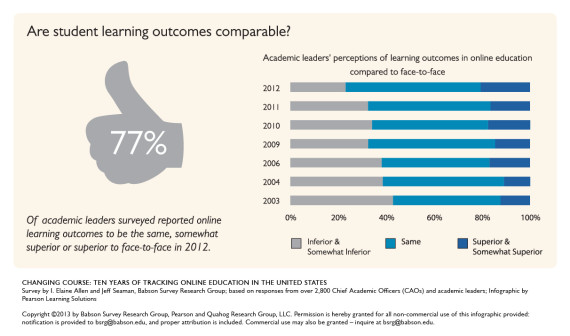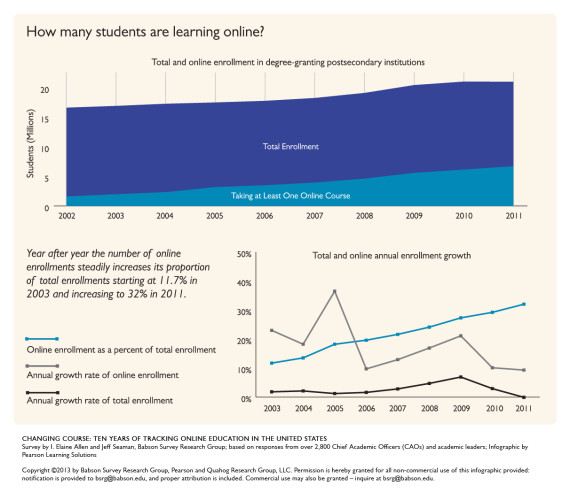In an effort to boost graduation rates among community college students in their state, the California Community College Chancellor’s Office, with funding from the state legislature, will implement the Online Education Initiative (OEI) this fall. The central tenet of the OEI is to expand course offerings and related online services to help students obtain a degree or facilitate transfer to another California institution for matriculation. For years, budget cuts have greatly impacted the course offerings of the state’s community college system, leaving hundreds of thousands of potential students shut out of the system. State education officials hope that this new online portal will open the doors to those students. It is also hoped that expanded access to courses will improve student retention and thus lead to more degrees and certificates being conferred, particularly among underserved and underrepresented populations in the state.
Particulars of the Californhttps://cvc.edu/about-the-exchange/ia Community College Online Education Initiative
The OEI will operate under a single delivery modality called the Online Education Ecosystem. This centralized online portal would essentially leverage the power of all member institutions to deliver a highly robust online learning experience that would be difficult for individual institutions to develop and deploy on their own. The system will be built on the existing foundation of the California Virtual Campus, which provides information about online courses offered throughout the state. At present, the system includes 24 of California’s 112 community colleges. Each of the 24 institutions is currently engaged in a pilot phase in which they are responsible for devising and testing components of the system, including course management tools, student orientation and preparedness programs, and online tutoring services. This first phase of the OEI will begin this fall and will run through the spring of 2016.
Students enrolled in one of the member institutions will be able to apply, register, and take online courses from any of the other member institutions, thus greatly expanding the pool of courses in which a student can participate. For example, a student at Victor Valley Community College who wants to take a psychology class that isn’t offered at their institution could take that course through Barstow Community College instead. Rather than receiving academic support from Victor Valley faculty and staff, students would receive 24-hour a day, seven day a week support from the Online Education Ecosystem, which is funded and supported by the OEI. In short, rather than having dozens of independent online programs throughout the state, the OEI brings the programs of participating institutions under their umbrella, allowing students to tap in to the course offerings of other schools, yet receive credit at their “home” institution.
An additional component of the OEI is that students will have greater possibilities for obtaining credit through examination. The California Community Colleges Chancellor’s Office will devise “challenge exams” for core courses in certain associate’s degree programs. Challenge exams will also be available for certain remedial courses. To acquire the essential knowledge and skills required for proficiency on these exams, students would have the option of taking part in Massive Open Online Courses (MOOCs), which are large-scale college classes typically open to anyone and offered free of charge. As with the creation of the OEI itself, the purpose of offering expanded opportunities to test out of certain classes is to promote retention and improve graduation rates for the state’s community college students.
Local Control
While the OEI greatly expands the ability for students to undertake studies of their choice, it has come under fire, particularly from community college faculty. Dean Murikami, president of the community college faculty association, is concerned about the lack of local control over the courses because online students, like on-campus students, need “access to our counselors, our support services, and our tutors” in order to be as successful as possible. Detractors of a single statewide system of online education point out that online students are more likely to fail or dropout than their face-to-face counterparts. Students who take more online than on-campus credits are also less likely to graduate.
Critics of the OEI worry that the problems of online courses, which are evident at schools across California and the nation, would only be exacerbated if students are yet another step removed from their professors. However, there is extremely high demand for virtual courses at the community college level. The number of students in the United States enrolled in online courses grew from just 700,000 in 1998 to well over 7 million in 2013. In California, the percentage of community college students taking an online class grew from 12.5 percent in 2006 to 27 percent in 2012. What’s more, as of 2012, half of California’s community colleges offered at least one degree or certificate program that could be obtained completely online. Thus, despite the criticisms by some of online learning, the potential for growth in that sector is just too good to pass up.

In an effort to balance the need for online expansion (and student demand for it) with the concerns of faculty over losing local control of curriculum and instruction, the OEI and its partner schools have devised several contingencies:
- Peer review of course proposals: All courses will be examined and approved by participating faculty before classes go live. This includes instructional design procedures and how courses are proctored, as well as how exams are structured in order to provide students with a comparable class experience regardless of who teaches their class or with what institution their professor is affiliated.
- Online tutoring: After a study revealed that more than half of online students at San Diego State University failed, member schools of the OEI will offer one-to-one online tutoring to ensure students have support resources similar to those that on-campus students enjoy.
- Enrollment limits: Some colleges in the OEI will cap enrollment at 45 students per course to facilitate higher quality professor-student interaction.
- Standardized procedures and management: All students, regardless of their “home” institution will access the online environment in the same manner, using the same interactive portal. Additionally, all classes will be managed using the same course management system, so professors from each member institution will use the same environment to carry out classes and interact with students.
- Student readiness: OEI member schools will devise and deploy an online student orientation module that prepares students to be successful in an online classroom environment. The system will also be able to analyze student data in order to diagnose a student’s readiness for the rigors of online learning.
Advantages of Online Courses
The primary advantage for students who take online courses is the flexibility with which they are able to undertake their studies. According to research, 68 percent of online students prefer virtual studies because they are too busy to attend face-to-face classes.

In light of the characteristics of the average online student - female, 33 years old, and taking courses to advance in her current career or change careers altogether – online learning is a great choice. Virtual courses allow people who are employed full-time to work around their already busy schedules while still obtaining their goal of a degree or certificate. It’s a good option for students who have families as well, because virtual learning doesn’t necessarily interrupt picking up kids from school, dinnertime, or other family-related activities. Other primary advantages to online learning include:
- Accelerated courses: Many colleges offer accelerated options for students who wish to complete a semester-length course in as little as eight weeks.
- Faster completion: Some online course options allow students to fast-track not just individual courses, but their entire degree program.
- More choice: Online course offerings are incredibly robust, and at some community colleges, extend far beyond what is offered to students on campus. Choices are expanded even further as a result of the cooperation of the members of the OEI.
- Self-paced learning: The self-paced nature of online studies is highly attractive to students that are disciplined, independent learners.
- No travel: Students can study anywhere and at anytime. This is especially convenient for students that do not have their own transportation or who cannot afford the time involved in commuting back and forth between home and campus.
For community colleges, online learning represents a large fiscal advantage. Increasing on-campus programming entails renovations to, expansion of, or construction of new facilities. From more parking lots to expanded food service options, when community colleges grow, so too does the need for campus updates. While these capital construction projects can be incredibly expensive, expanding the online campus is not. Additionally, offering a virtual learning experience expands the footprint of community colleges to a much larger audience. While most online students live within 100 miles of their school, that school nevertheless has the ability to enroll students throughout the country and the world – all without having to pay for expansion of their brick-and-mortar campus.
Disadvantages of Online Courses
Students who take online courses report a number of anxieties regarding their studies. First and foremost in students’ minds is whether or not they will have time to dedicate to their studies. For online students this is of great concern because of the self-discipline required for the individualized nature of a virtual education.
A second disadvantage most often cited by online students is the knowledge necessary to navigate online class environments, as well as the technical requirements in terms of computer hardware and software. Students also express dismay about the lack of readily available resources, such as access to their institution’s library materials.

As mentioned above, education officials point to the failure and dropout rates for students in online courses as a significant disadvantage to the virtual platform. According to a report by the New York Times, some massive open online classes (MOOCs) lose 90 percent of their students over the course of the semester. While the overall failure rate of students enrolled in more traditional online courses at California community colleges is just 7 percent, it is still a higher attrition rate than for students taking the same class on campus. Other commonly noted disadvantages to virtual learning include:
- Reduced interaction with classmates;
- Inconsistent communication and/or inadequate communication from professors;
- Increased difficulty than in comparable on-campus courses;
- Perceptions by those in the education field and among the general public that online courses lack quality.
Additionally, online learning takes a special kind of student that is both highly motivated and highly skilled. Students who need remediation, of which there are many at the community college level, those that struggle with time management, or those that simply need the in-class interaction with their professor in order to succeed, are certainly not good candidates for online learning.
It is precisely these students that critics of the OEI are concerned about – students with a lack of resources, skills, and confidence who more often than not are doomed to failure in an online environment, yet who want to improve themselves. They may work one, two, or three jobs, have family commitments, or lack reliable transportation, all of which serve as barriers to on-campus attendance and which make online learning look like an attractive option.
Looking Ahead
Time will only tell if the OEI system is successful or not. While there are legitimate concerns from students, faculty members, and collegiate institutions themselves, the expansion of collegiate opportunities is both exciting and much needed. Community colleges have long since been on the front lines of education, often serving as the primary entry point into higher education for women, minorities, poverty-stricken students, and those who benefit from smaller class sizes and more interaction with their professors. The OEI represents a vehicle by which these historically underserved populations will be able to obtain the credentials they need to get better jobs or advance in their current careers.
The component of the OEI that will likely prove to be the most important is the student services module. The complaints of online students that they feel disconnected from their professors and school staff must be addressed if students are to be successful taking a course offered by an institution other than their own. Having online tutoring options, faculty-student discussion forums, and guidance services for scheduling, credit checks, assistance with transferring, and financial aid is essential for ensuring student success. Fortunately, students will reap the benefits as the OEI is taking a proactive approach in making these accommodations before they ever enroll a single student.















